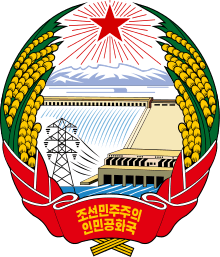Democratic Front for the Reunification of the Fatherland
| Democratic Front for the Reunification of the Fatherland | |
| Chosŏn'gŭl | 조국통일민주주의전선 |
|---|---|
| Hancha | 祖國統一民主主義戰線 |
| Revised Romanization | Joguk tong(-)il minju juui jeonseon |
| McCune–Reischauer | Choguk t'ongil minju chuŭi chŏnsŏn |
 |
| This article is part of a series on the politics and government of North Korea |
|
|
| Foreign relations |
The Democratic Front for the Reunification of the Fatherland (also known as the Fatherland Front), formed on 22 July 1946,[1] is a North Korean united front led by the Workers' Party of Korea. It was initially called the North Korean Fatherland United Democratic Front.[2]
The three political parties of North Korea—the Workers' Party, the Korean Social Democratic Party, and the Chondoist Chongu Party, all participate in the front. Other member organizations include social groups and youth groups, such as the Korean Children's Union, the Kimilsungist-Kimjongilist Youth League, Young Pioneer Corps, the Socialist Women's Union of Korea and the Korean Red Cross society.[3]
In practice, only the Workers' Party holds any real power at the national level. The two minor parties in the front are completely subservient to the Workers' Party, and serve merely to keep up the appearance of pluralism. Indeed, virtually nothing about their activities is reported in the press beyond the names of their leaders. All of the parties and their leaders are mere puppets of the regime, having jettisoned their ideology to become loyal partners to the workers' party. [4]
All candidates for elective office must be members of the front, and are elected by it; mass meetings are held to decide which candidates will be nominated and their names can go on the ballot paper only with the approval of the meeting.[5]
There is an ostensible South Korean counterpart for the DFRF, known as the Anti-Imperialist National Democratic Front, which operates in North Korea.
References
- ↑ "Democratic Front for the Reunification of the Fatherland". Naenara.kp. 2004. Archived from the original on 4 December 2008.
- ↑ Andrei N. Lankov (2001). "The Demise of Non-Communist Parties in North Korea (1945–1960)". jhu.edu. Retrieved 8 September 2015.
- ↑ "Democratic Front for the Reunification of the Fatherland". Encyclopedia of the Nations. Retrieved 31 August 2006.
- ↑ Andrea Matles Savada, ed. (1993). Mass Organizations "North Korea: A country study - Mass Organizations" Check
|url=value (help). Washington: GPO for the Library of Congress. Retrieved 8 September 2015. - ↑ "The Parliamentary System of the Democratic People's Republic of Korea" (PDF). Constitutional and Parliamentary Information. Archived from the original (PDF) on 19 August 2006. Retrieved 1 October 2006.